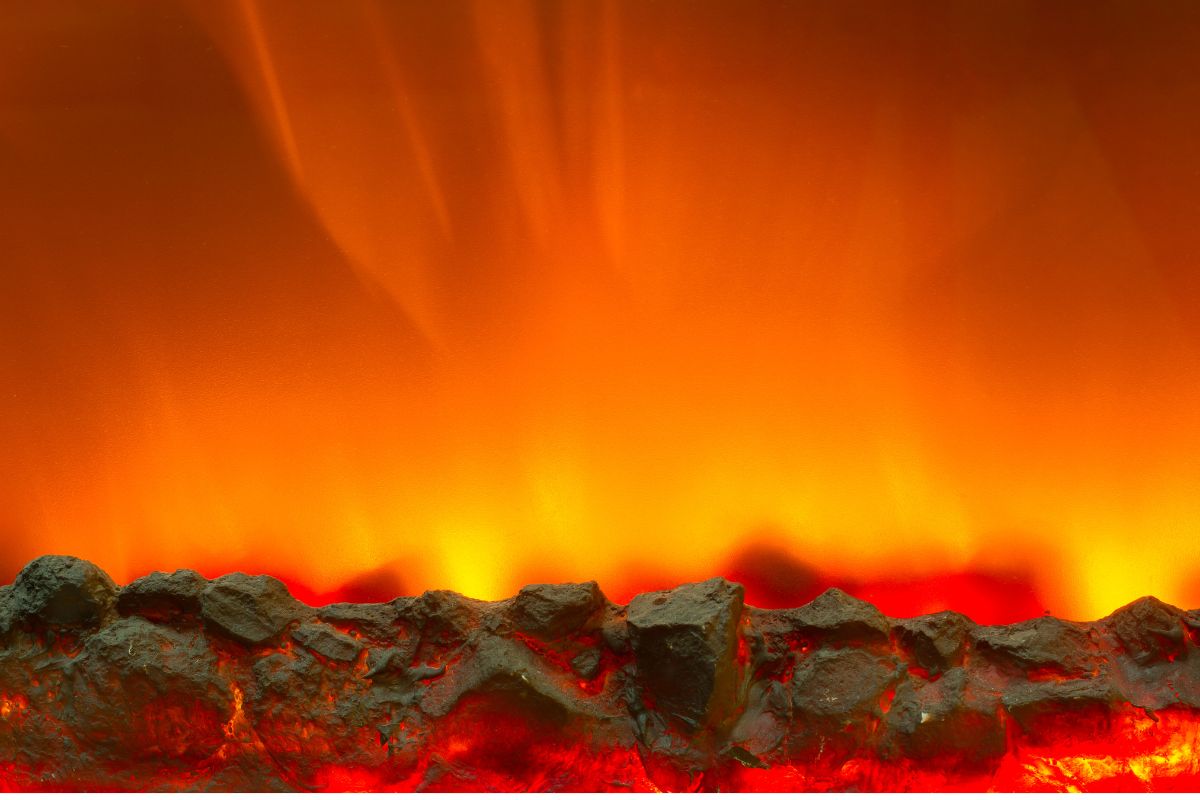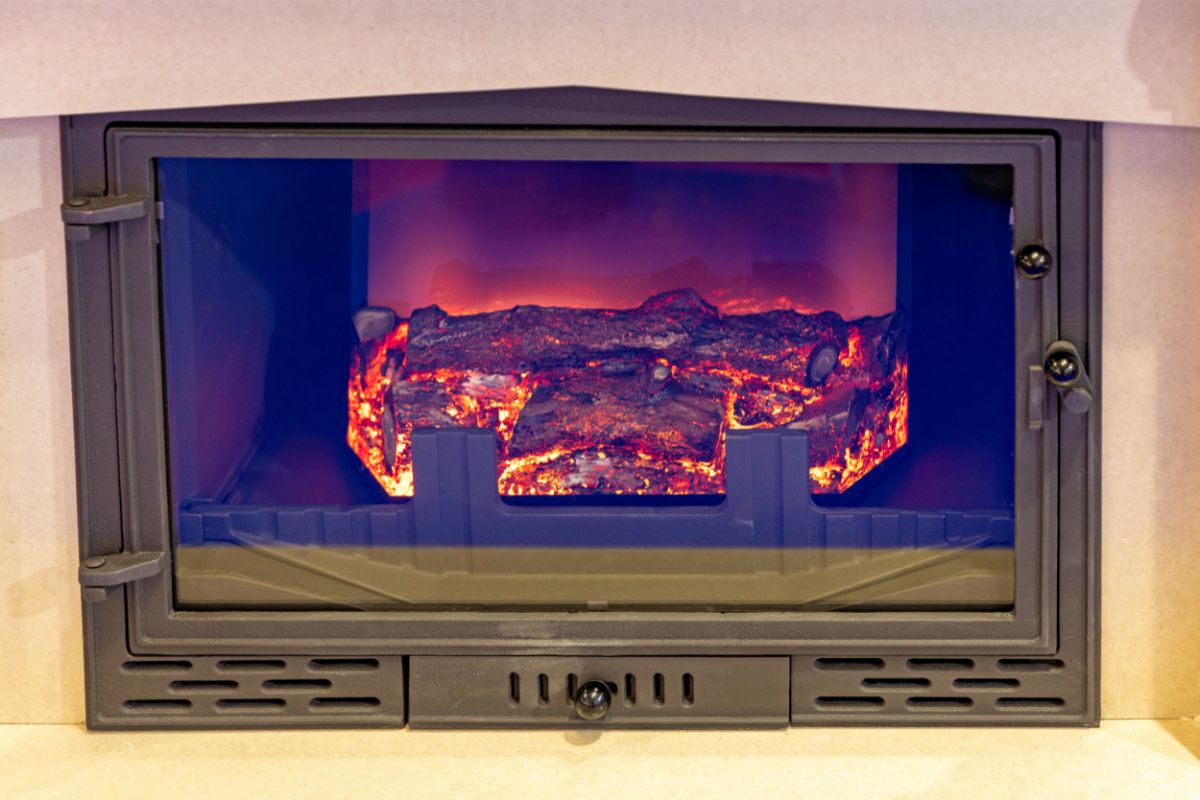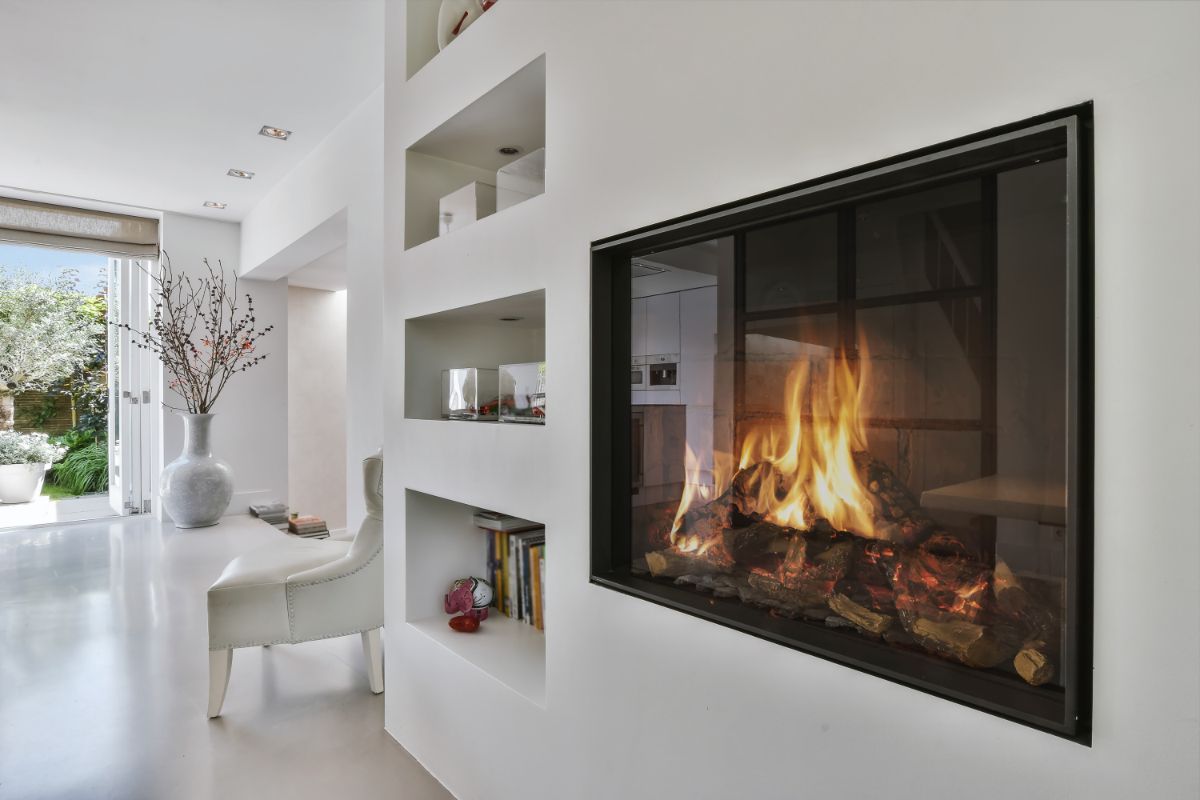Since an electric fireplace lacks a true flame, it must find another means to generate heat.

Using an infrared heater is one of the methods an electric fire can generate heat.
An electric fireplace that uses infrared heating technology is referred to as an infrared electric fireplace. When compared to traditional fan-forced heaters, infrared heaters can often produce more heat instantly and heat greater areas.
In this article, we go into more detail on what exactly an infrared electric fireplace is, how it differs from a traditional fan-forced electric fire, and which one is preferable.
What Is An Electric Infrared Fireplace?
Electric fireplaces don’t use a real fire to create flames and heat. Instead, to replicate the appearance of flickering flames, the flames are often produced by combining lights and revolving mirrors.
Since an electric fireplace lacks a true flame, heat must be produced in another way.
Because electric fireplaces are powered by electricity, a room must be heated with an electrical heater. The following heaters are most frequently seen in electric fireplaces:
- Infrared heater
- Fan forced heater
Many electric fireplaces provide heat using the more traditional fan forced heating approach. Air is drawn in and driven over a heating element in a fan-forced electric fireplace prior to getting blown back into the space.
An electric fireplace is most likely using a fan heater if it is not using an infrared heater.
Infrared heating technology may also be used in electric fireplaces in place of a fan-forced heating system to produce heat.
A quartz tubing heater is used to produce heat in infrared heaters. An infrared electric fireplace, as its name implies, emits heat in the state of infrared light.
The normal heating capacity of a fan-forced electric fireplace is 400 square feet, while the typical heating capacity of an infrared electric fireplace is 1000 square feet.
Additionally, when placed across the room from an infrared fireplace, you will often feel the heat more immediately than you would with a traditional fan-forced electric fireplace.
This is because, unlike with a fan-forced electric fireplace heater, the heat is radiated into the space rather than warming the air as it travels through a heating element.
Because the air hasn’t been heated up as much as with a fan pushed heater, the heat from an infrared fireplace won’t last as long.
Infrared heaters are not always used in electric fireplaces. Especially in the more affordable types, fan-forced heaters may be more frequent in electric fireplaces than infrared heaters. Some electric fireplaces could be completely devoid of heaters.
In this article, we go into further detail regarding the advantages and disadvantages of infrared heaters.
What Are The Differences Between An Infrared And An Electric Fireplace?
A form of fireplace that generates heat using electricity is an electric fireplace. The primary distinction among an electric fireplace and infrared fireplace is the heating method used by the two types of fireplaces.

Conventional electric fireplaces employ fan-forced heating components, whereas infrared electric fireplaces utilize infrared technology.
A fan-forced heater may be used in place of an infrared heater in an electric fireplace, which is still an infrared fireplace.
Electric fireplaces that generate heat by using a traditional fan mechanism to force air over a heat element to warm a space can be seen frequently.
A blower and a heating element are located within a fan heater. It functions by drawing air in and pushing it via a heating element towards the front of your fireplace. The air in the room gets warmer the longer a fireplace is on.
The normal heating capacity of electric fireplaces that use this fan heating method is 400 square feet. A room needs some time to warm up as well (we timed it here), but once the fireplace is switched off, the heat can be kept in the space for a short period.
Some electric fireplaces employ an infrared heater to produce heat instead of a fan-forced heater.
You may feel the warmth of infrared light coming from an electric fireplace that emits it on your body. An infrared fireplace operates without a fan, making it quieter than fan-driven electric fireplaces.
Due to the fact that infrared heating doesn’t require preheating the room’s air, you may experience the heat much more rapidly.
On the disadvantage, compared to using fan-forced electric fireplaces, the heat from the area can be lost more rapidly when switched off.
Additionally, infrared heaters can often heat rooms up to 1000 square feet in size.
Due to the additional advantages of infrared heating, infrared electric fireplaces may cost more to purchase than traditional fan electric fireplaces.
Which Is Better: An Infrared Or Electric Fireplace?
Infrared electric fireplaces have the potential to be a more effective heating option than fan-forced electric fireplaces because they can often heat a greater space more quickly. But infrared heaters are usually only seen in more expensive electric fireplace models.
Even though other kinds of electric fireplaces more frequently employ a traditional fan driven heating system using a heat element and blower to deliver heat, infrared electric fires use infrared to heat a room.
Compared to fan-forced electric fireplaces, infrared fireplaces can frequently heat a greater space more quickly, but they are less effective at keeping the room warm after they have been turned off.
When contrasted to electric fireplaces with fan-forced heaters, infrared fireplaces are often more expensive.
Therefore, an electric fire that utilizes an infrared heater can be a better option for you if you’re seeking the best heater for your electric fire, would like to be capable of heating a bigger area of your home, and don’t mind paying more.
Look for an electric fire that employs a traditional fan driven heating system if you simply would like to be able to warm a small room of around 400 sq ft or less, don’t mind the added fan sounds, can wait a little longer to feel the heat, and don’t want to spend lots of money.
Infrared Electric Fireplace Advantages
Owning an electric fire with infrared heating has the following advantages:
- As you can often feel the warmth from a greater distance than you can with fan heaters, infrared heating systems can usually heat a bigger area.
- Since there is no blower, they operate quite quietly.
- Heat that is almost immediate. The infrared heaters may take a little longer to warm up, but once they do, the heat will be felt immediately on your body.
Infrared Electric Fireplace Disadvantages
Although owning an infrared fire has numerous benefits, there are a few drawbacks as well:
- Usually more expensive.
- The heat doesn’t last as long when an infrared fireplace is turned off as it would with a fan-forced electric fireplace.
Final Thoughts
Hopefully this article has helped you to determine whether purchasing an infrared fireplace is the right choice for you.
This type of fireplace has numerous advantages such as greater heating power and quiet operation, but it also has drawbacks such as the price tag and time length of heating. Make sure to weigh your options up before you invest in a new fireplace!
- Discover the Ease and Elegance of Zero-Clearance Fireplaces - July 24, 2023
- How to Build a Frame for an Electric Fireplace Insert: A Step-by-Step Guide - July 16, 2023
- Bedroom Fireplace Ideas That Will Make You Want to Snuggle Up - July 16, 2023








